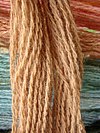Mordant
In the past, it was thought that a mordant helped the dye "bite" onto the fiber so that it would hold fast during washing.
[citation needed] Iodine is often referred to as a mordant in Gram stains, but is in fact a trapping agent.
[5] Residual iron mordant can damage or fade fabric, producing "dye rot".
[3] The type of mordant used can change the colour of both the dye-plus-mordant solution and influence the shade of the final product.
Wool also has a tendency to absorb fine precipitates from solutions; these cling to the surface of fibres and dye particles attached to these contaminants result in poor rubbing fastness.
Methods for mordant application depend on the desired stain and tissues under study; pre-, meta- and post-mordanting techniques are used as required.




